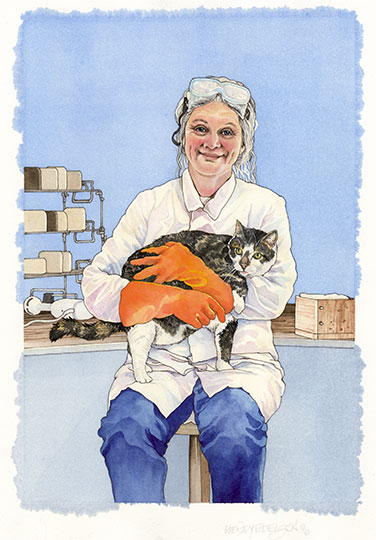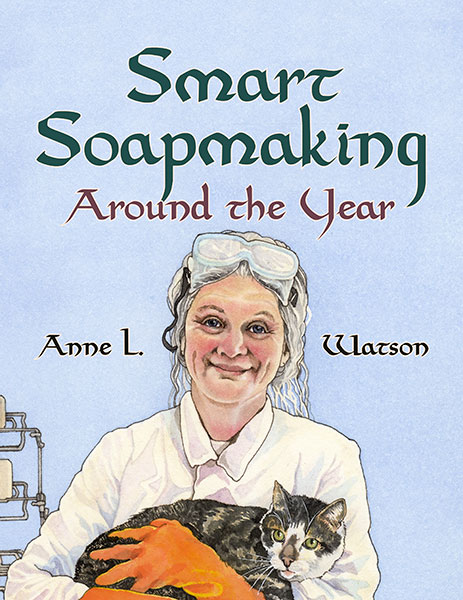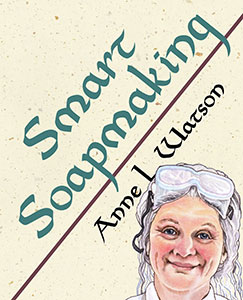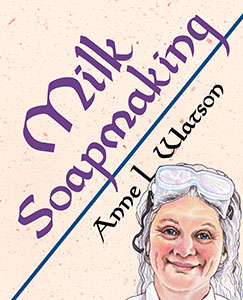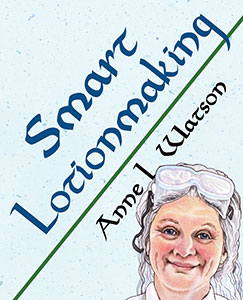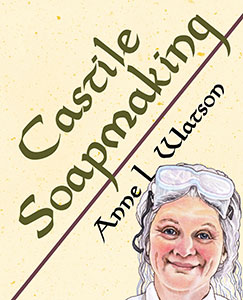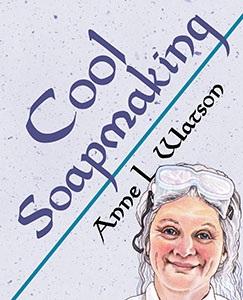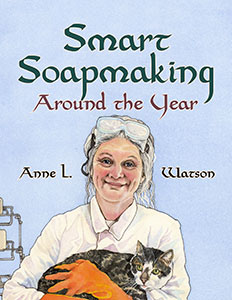Before We Begin
JANUARY—SEA SOAPS
Sea Products in Soapmaking—Why?
Salt Soap
Seaweed Soaps
100% Coconut Oil Soap
Sand Soap
Classic Soap Ads—Sapolio
What Would I Do?
Soap Equipment—Tips and Tricks
Soap Ingredients FAQ
Soaps from the Past—Aleppo Soap
FEBRUARY—CHOCOLATE SOAPS
Chocolate in Soapmaking—Why?
Kinds of Chocolate for Soapmaking
Cocoa Butter as a Soapmaking Fat
Using Chocolate Products in Soapmaking
Do Chocolate Scent and Color Survive?
Dark Chocolate Soap
Cocoa Butter Soap
Chocolate Coconut Soap
Chocolate-ish Soap
Chocolate Scents
Vanilla and Discoloring
What Would I Do?
Resizing a Soap Recipe
Soaps from the Past—Marseille Soap
MARCH—LAUNDRY SOAP
Homemade Laundry Soap—Why?
Ingredients for Homemade Laundry Soap
Basic Laundry Soap #1
Basic Laundry Soap #2
Grating Soap
Soaps from the Past—Laundry the Old Way
Castile Soap—Why?
Castile Soap Experiments
Easy Castile Soap with Variations
Increasing Lather
Dog Soap
What Would I Do?
Soaps from the Past—Historical Castile Soap
APRIL—EGG SOAPS
Eggs in Soapmaking—Why?
Egg Yolk Soap
Swedish Egg White Soap
Cool Whole Egg Soap
Does Egg Soap Spoil Quickly?
Designing Soaps for Different Uses
Analyzing and Fixing Problems
Soaps from the Past—Additives in Soap
MAY—SILK SOAPS
Silk in Soapmaking—Why?
Using Silk in Soapmaking
Using Floral Scents
Flowers-and-Silk Soap
Floral Soap with Coconut Milk
Using Fruit Fragrances
Soaps from the Past—Wild, Weird, and Wonderful Soap Ads
JUNE—CUCUMBER SOAPS
Cucumbers in Soapmaking—Why?
Avoiding Burned Cucumber Odor
Basic Cucumber Soap and Variations
Cucumber and Apricot Soap
Cucumber and Avocado Soap
Color—Natural and Artificial
Hardness
Does Cucumber Accelerate Trace?
What Would I Do?
Low Temperature Soapmaking
JULY—CITRUS SOAPS
Citrus in Soapmaking—Why?
Fading and Citrus Essential Oils
Basic Citrus Soap and Variations
Texas Ruby Red Grapefruit Soap
Lemongrass, Coconut, and Almond Soap
Creamy Orange Soap
What Would I Do?
Soapmaking as a Business
AUGUST—HERBAL SOAPS
Herbs in Soapmaking—Why?
Botanicals in Soap
Infusing Oils with Herbs
Herb Teas
Herb Essential Oils and Fragrances
Botanicals and Lye
Basic Herbal Soap and Variations
Coconut Almond Soap with Herb Tea
Triple Calendula Soap
Tomato Basil Soap
Lavender, Shea, and Almond Soap
Working with Accelerants
What Would I Do?
SEPTEMBER—OATMEAL SOAPS
Oatmeal in Soapmaking—Why?
Rolled Oats and Oat Flour
Honey and Beeswax
Liquids—Milk, Cream, and Oat Milk
Cinnamon and Other Spices
Oatmeal, Milk, and Honey Fragrance Oils
Basic Oatmeal Soap and Variations
Oatmeal, Wheat Germ, and Buttermilk Soap
What Would I Do?
Selecting Vendors
OCTOBER—BEER AND WINE SOAPS
Beer and Wine in Soapmaking—Why?
Experimenting—Why?
Using Alcoholic Beverages in Soapmaking
Basic Beer Soap and Variations
All-Veg Beer Soap
Trying Wine in Soapmaking
Wine Soap Experiments and Recipes
What Would I Do?
Developing Your Own Recipes
An Approach to Experimenting
NOVEMBER—NATURAL COLORANTS
Natural Colorants in Soapmaking—Why?
Using Natural Colorants in Soapmaking
Colors, Oils, and Soap
Plant-Based Colorants
Other Natural Colorants
Basic Colored Soap #1
Basic Colored Soap #2
Alkanet Root Soap Experiment
Madder Root Soap Experiment
Pumpkin Pie Soap
What Would I Do?
Taming the Soda Ash Monster
DECEMBER—WOOD SOAPS
Wood Scents in Soapmaking—Why?
Basic Wood Soap and Variations
Evergreen and Other Tree Essential Oils
Sandalwood EO vs. FO—Is the Difference Worth the Cost?
Soaps from the Past—Pine Tar Soap
Easy Pine Tar Soap
What Would I Do?
Fragrances and Essential Oils for Gift Soaps
Holiday Fragrance Oils
Gift Soap in a Hurry
Packaging Soaps for Gifts
Giving a Soapmaking Lesson
Shaving Soap
Home Fragrancing
